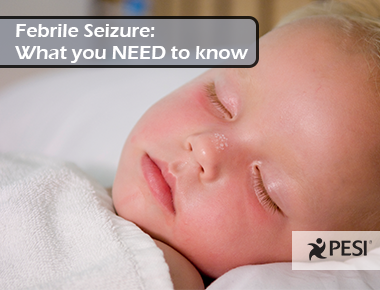When a Child's Fever Turns Into a Nightmare
Maria Broadstreet, RN, MSN, CPNP

Watch this 53-second video, and see if you diagnose this case study correctly...
If you guessed febrile seizure, you're correct.
PESI speaker Maria Broadstreet, R.N., MSN, CPNP, has over 20 years of experience working with children. Her son and daughter have both experienced febrile seizures, and while they're typically harmless, they can be alarming and terrifying—even for a mother with years of experience in the health care field. Here's what you need to know...What is a febrile seizure?
Febrile seizure are convulsions brought on by a fever in infants or small children. During a febrile seizure, a child often loses consciousness and shakes, moving their limbs on both sides of the body. These seizures typically last a minute or two, but can be as brief as a few seconds and as long as 15 minutes.
How often do febrile seizures happen?
One in every 25 children will have at least one febrile seizure, typically between the ages of 6 months and 5 years. The older a child is when they experience their first febrile seizure, the less likely that child is to have more.
What are the risk factors for febrile seizures?
Children who are younger than 15 months, have frequent fevers, and have family members with a history of febrile seizures are more likely to experience febrile seizures.
Are febrile seizures harmful?
Most febrile seizures are short and harmless, and there is no evidence that short febrile seizures cause brain damage. There is a small chance that a child may be injured by falling or choking from food or saliva in the mouth.
How is a febrile seizure treated?
There is no treatment for a true febrile seizure. Fever-lowering drugs such as acetaminophen or ibuprofen should be given at the appropriate dosage for the child. If the seizure lasts 10 minutes, the child should be taken immediately to the nearest medical facility. Once the seizure has ended, the child should be taken to his or her doctor to investigate the source of the fever.
Children that are especially prone to febrile seizures may be treated with the drug diazepam, either orally or rectally, whenever they have a fever.
What does the American Academy of Pediatrics recommend?
Clinicians evaluating infants or young children after a simple febrile seizure should direct their attention toward identifying the cause of the child's fever. In general, a simple febrile seizure does not usually require further evaluation, specifically electroencephalography, blood studies, or neuroimaging.
You can learn more about treating pediatric patients from Maria Broadstreet's CE Seminar...
Topic: Pediatrics
Tags: Case Study | Febrile Seizure



